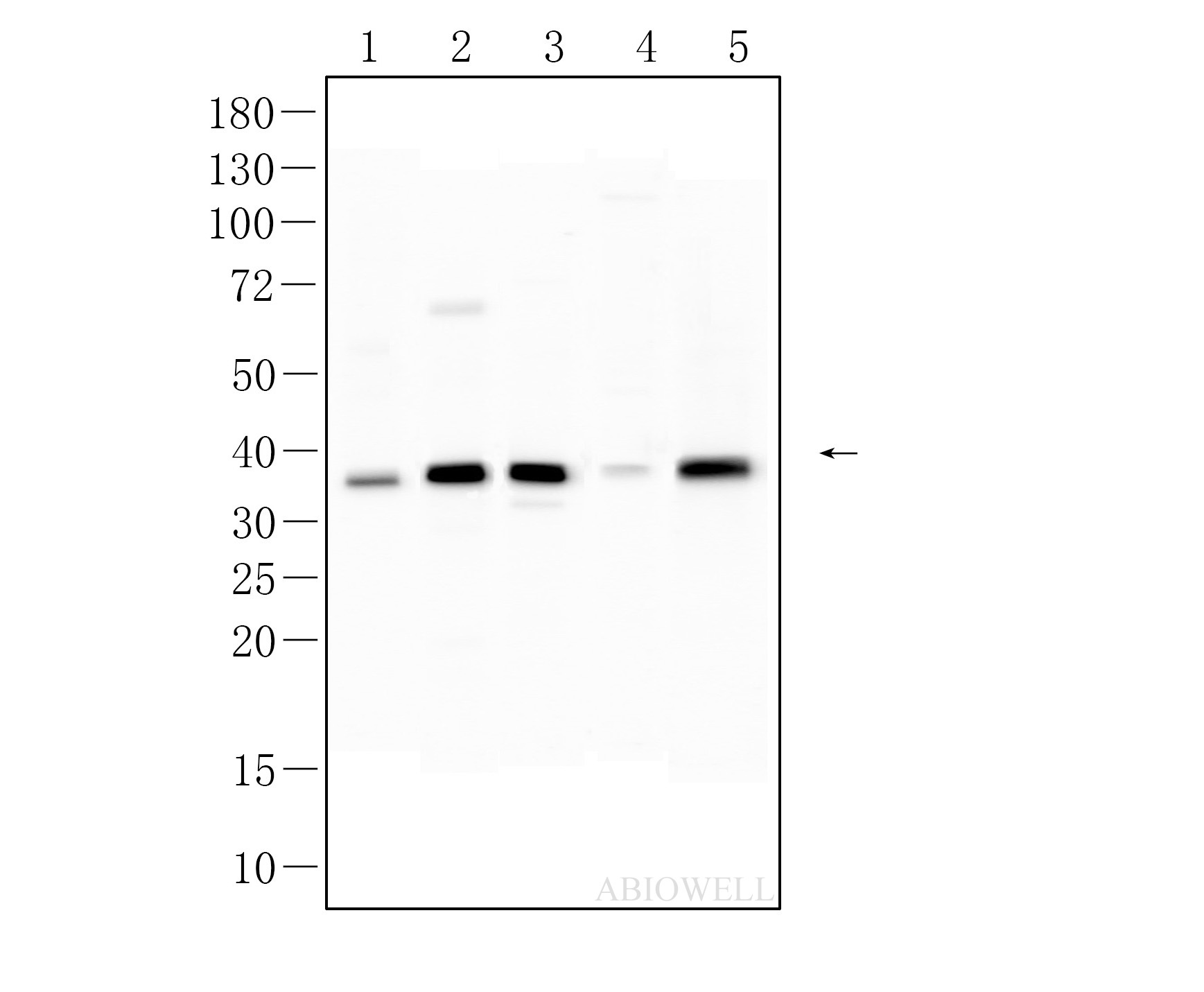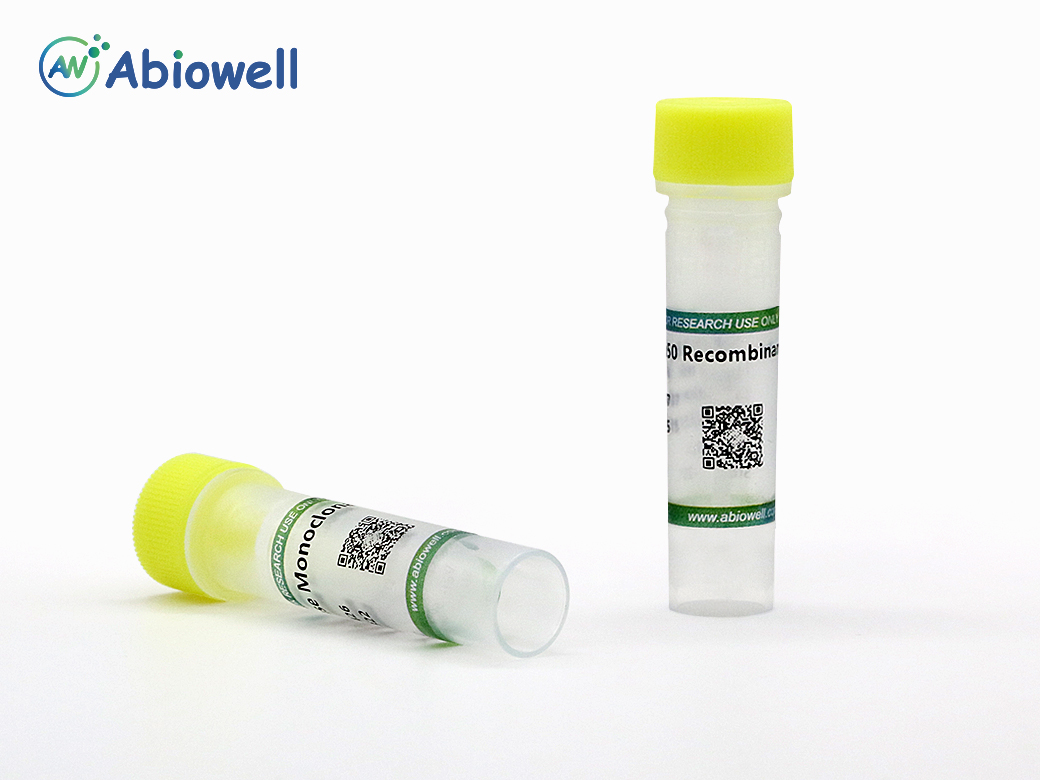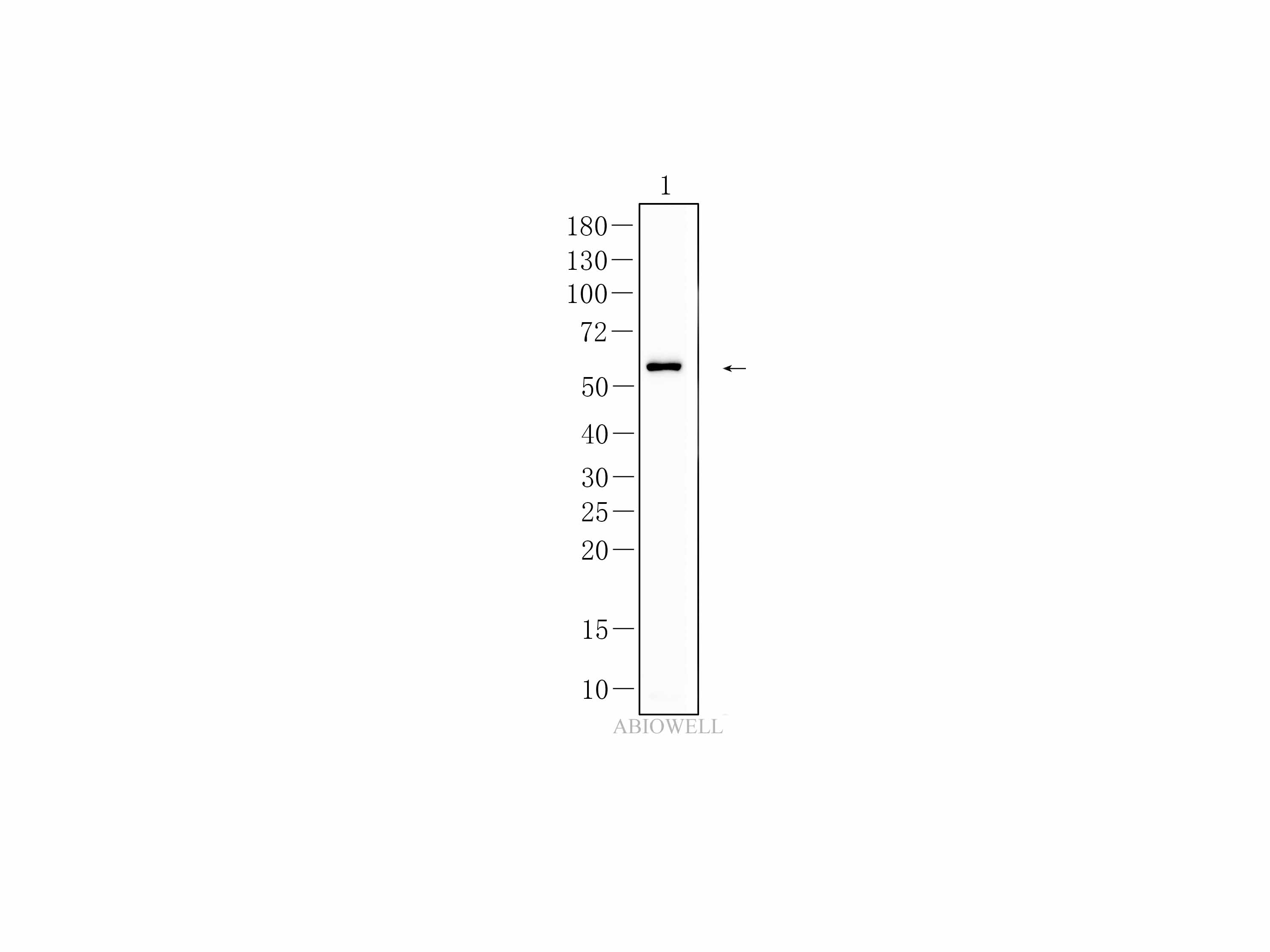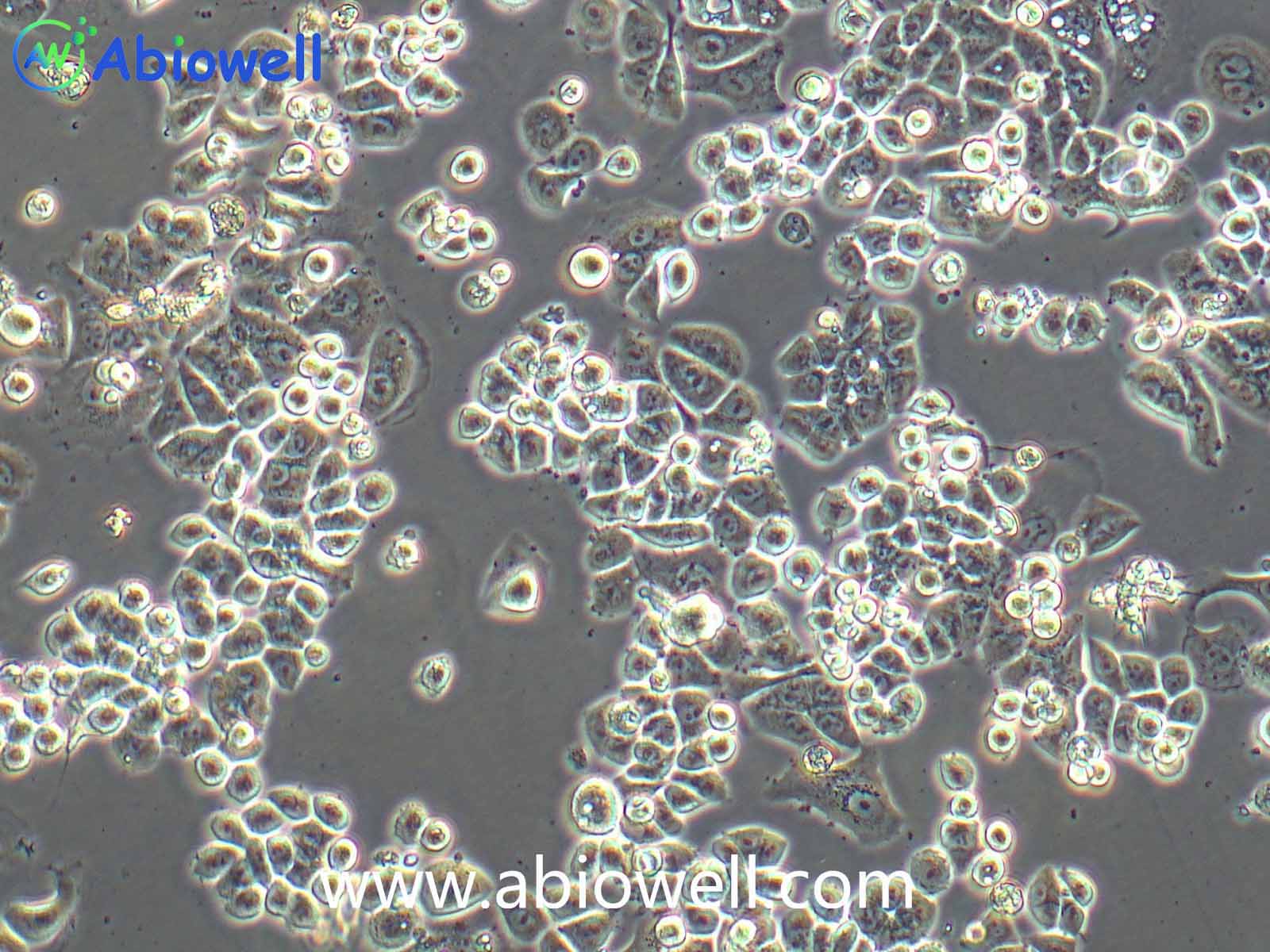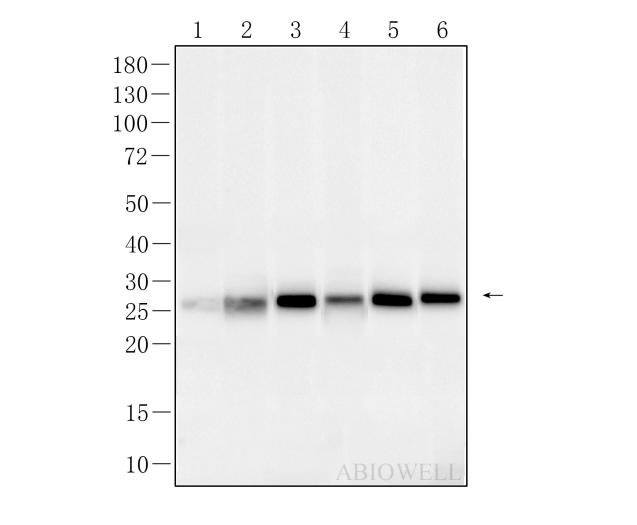HMGB1 Recombinant Rabbit Monoclonal Antibody
-
-
- 20μL
- ¥620
- 1-3个工作日
-
- 50μL
- ¥1250
- 1-3个工作日
-
- 100μL
- ¥2200
- 1-3个工作日
Product Details
| Host Species: Rabbit | Reactivity: Human,Mouse,Rat | Molecular Wt: 25 kDa | |
Clonality: Monoclonal | Isotype: IgG | Concentration: 1 mg/ml | ||
Other Names: high mobility group box 1; High mobility group protein 1; High mobility group protein B1; HMG 1; HMG1; HMG3; HMGB1; SBP 1
| ||||
Formulation: Liquid in PBS containing 50% glycerol, 0.5% BSA and 0.02% sodium azide. | ||||
Purification: Affinity-chromatography | ||||
Storage: -20°C,1 year | ||||
Applications
| WB 1:1000-1:50000 IHC-P 1:200-1:2000 IF-C 1:50-1:500 IF-T 1:100 FCM 1:50-1:1000
| |||
Immunogen Information | Gene Name: HMGB1 | Protein Name: High mobility group protein B1 | ||
Gene ID: 3146 (Human) 15289 (Mouse) 25459 (Rat)
| SwissPro: P09429 (Human) P63158 (Mouse) P63159 (Rat) | |||
Subcellular Location: Cytoplasm, Nucleus, Cell membrane, Secreted, Chromosome. | ||||
Immunogen: Synthetic peptide within Human HMGB1. AA range: 151-200. | ||||
Specificity: HMGB1 Monoclonal Antibody detects endogenous levels of HMGB1 protein. | ||||
| Product images | |
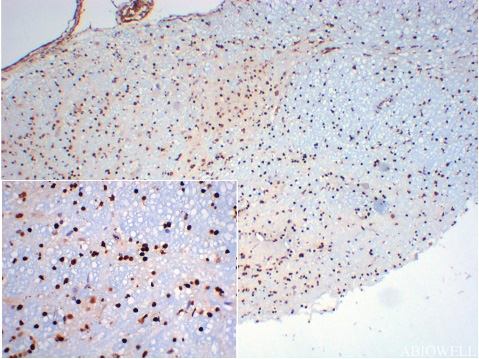
|
Fig : Immunohistochemical analysis of paraffin-embedded Rat-cerebellum tissue with Rabbit anti-HMGB1 (AWA10032) at 1/200 dilution. The section was pre-treated using heat mediated antigen retrieval with Sodium citrate buffer (pH 6.0) for 20 minutes. The tissues were blocked in 3% H2O2 for 15 minutes at room temperature, washed with ddH2O and PBS, and then probed with the primary antibody (AWA10032) at 1/200 dilution for 1 hour at room temperature. The detection was performed using an HRP conjugated compact polymer system(ABIOWELL, AWI0629). DAB was used as the chromogen. Tissues were counterstained with hematoxylin and mounted with DPX. |

|
Fig : Immunohistochemical analysis of paraffin-embedded Rat-kidney tissue with Rabbit anti-HMGB1 (AWA10032) at 1/200 dilution. The section was pre-treated using heat mediated antigen retrieval with Sodium citrate buffer (pH 6.0) for 20 minutes. The tissues were blocked in 3% H2O2 for 15 minutes at room temperature, washed with ddH2O and PBS, and then probed with the primary antibody (AWA10032) at 1/200 dilution for 1 hour at room temperature. The detection was performed using an HRP conjugated compact polymer system(ABIOWELL, AWI0629). DAB was used as the chromogen. Tissues were counterstained with hematoxylin and mounted with DPX. |
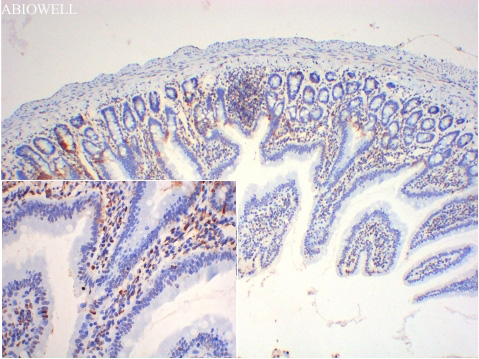
|
Fig : Immunohistochemical analysis of paraffin-embedded Rat-large intesstine tissue with Rabbit anti-HMGB1 (AWA10032) at 1/200 dilution. The section was pre-treated using heat mediated antigen retrieval with Sodium citrate buffer (pH 6.0) for 20 minutes. The tissues were blocked in 3% H2O2 for 15 minutes at room temperature, washed with ddH2O and PBS, and then probed with the primary antibody (AWA10032) at 1/200 dilution for 1 hour at room temperature. The detection was performed using an HRP conjugated compact polymer system(ABIOWELL, AWI0629). DAB was used as the chromogen. Tissues were counterstained with hematoxylin and mounted with DPX. |

|
Fig : Immunohistochemical analysis of paraffin-embedded Rat-liver tissue with Rabbit anti-HMGB1 (AWA10032) at 1/200 dilution. The section was pre-treated using heat mediated antigen retrieval with Sodium citrate buffer (pH 6.0) for 20 minutes. The tissues were blocked in 3% H2O2 for 15 minutes at room temperature, washed with ddH2O and PBS, and then probed with the primary antibody (AWA10032) at 1/200 dilution for 1 hour at room temperature. The detection was performed using an HRP conjugated compact polymer system(ABIOWELL, AWI0629). DAB was used as the chromogen. Tissues were counterstained with hematoxylin and mounted with DPX. |
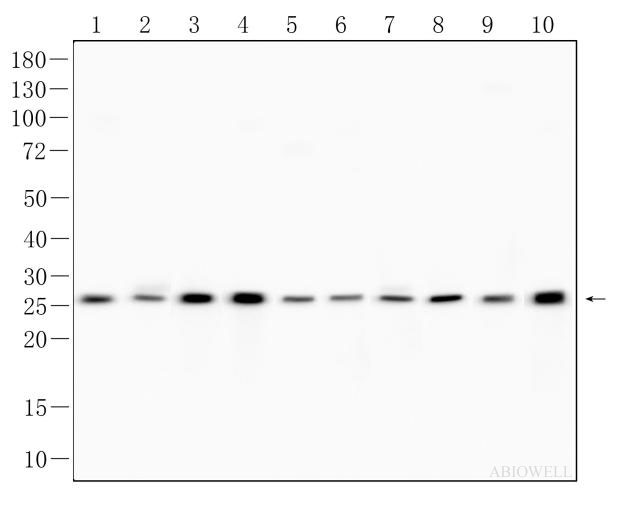
|
Fig : Western blot analysis of HMGB1 on different lysates. Proteins were transferred to a NC membrane and blocked with 5% NF-Milk in TBST for 1 hour at room temperature. The primary antibody ( AWA10032, 1/1000) was used in PBST at room temperature for 2 hours. Goat Anti-Rabbit IgG - HRP Secondary Antibody (AWS0002) at 1:5,000 dilution was used for 1 hour at room temperature. Positive control: Lane 1: NIH/3T3 cell lysate Lane 2: A2058 cell lysate Lane 3: HepG2 cell lysate Lane 4: HEPA1-6 cell lysate Lane 5: U251 cell lysate Lane 6: GL261 cell lysate Lane 7: K562 cell lysate Lane 8: RBL-2H3 cell lysate Lane 9: PC12 cell lysate Lane 10: Jurkat cell lysate Predicted molecular weight: 25 kDa Observed molecular weight: 26 kDa Exposure time: 7 seconds |

|
Fig : Western blot analysis of HMGB1 on different lysates. Proteins were transferred to a NC membrane and blocked with 5% NF-Milk in TBST for 1 hour at room temperature. The primary antibody ( AWA10032, 1/1000) was used in PBST at room temperature for 2 hours. Goat Anti-Rabbit IgG - HRP Secondary Antibody (AWS0002) at 1:5,000 dilution was used for 1 hour at room temperature. Positive control: Lane 1: Hela cell lysate Lane 2: HEK293T cell lysate Lane 3: C2C12 cell lysate Lane 4: RAW264.7 cell lysate Lane 5: A375 cell lysate Lane 6: MCF-7 cell lysate Lane 7: SHZ-88 cell lysate Lane 8: 4T1 cell lysate Lane 9: COS-7 cell lysate Lane 10: HCT116 cell lysate Lane 11: MC38 cell lysate Predicted molecular weight: 25 kDa Observed molecular weight: 26 kDa Exposure time: 7 seconds |

|
Fig: Immunocytochemistry analysis of HELA cells labeling HMGB1 with rabbit anti-HMGB1 antibody (AWA10032) at 1/50 dilution(green). Cells were fixed in 4% paraformaldehyde for 10 minutes at 37 ℃, permeabilized with 0.03% Triton X-100 in PBS for 30 minutes, and then blocked with 5% BSA for 60 minutes at 37 ℃. Cells were then incubated with rabbit anti-HMGB1 antibody (AWA10032) at 1/50 dilution in 2% negative goat serum overnight at 4 ℃. Goat Anti-rabbit IgG H&L (iFluor™ 488 AWS0005) was used as the secondary antibody at 1/200 dilution for 60 minutes at 37 ℃. Nuclear DNA was labelled in blue with DAPI(AWC0291). |

|
Fig: Immunocytochemistry analysis of Raw264.7 cells labeling HMGB1 with rabbit anti-HMGB1 antibody (AWA10032) at 1/50 dilution(green). Cells were fixed in 4% paraformaldehyde for 10 minutes at 37 ℃, permeabilized with 0.03% Triton X-100 in PBS for 30 minutes, and then blocked with 5% BSA for 60 minutes at 37 ℃. Cells were then incubated with rabbit anti-HMGB1 antibody (AWA10032) at 1/50 dilution in 2% negative goat serum overnight at 4 ℃. Goat Anti-rabbit IgG H&L (iFluor™ 488 AWS0005) was used as the secondary antibody at 1/200 dilution for 60 minutes at 37 ℃. Nuclear DNA was labelled in blue with DAPI(AWC0291). |

|
Fig: Fluorescence immunohistochemical analysis of Mouse-cerebellum tissue (Formalin/PFA-fixed paraffin-embedded sections) with Rabbit anti-HMGB1 antibody (AWA10032) at 1/200 dilution. The immunostaining was performed with the TSA Immuno-staining Kit (ABIOWELL, AWI0688). The section was pre-treated using heat mediated antigen retrieval with Sodium citrate buffer (pH 6.0) for 20 minutes. The tissues were blocked in 3% H2O2 for 15 minutes at room temperature, washed with ddH2O and PBS, and then probed with the primary antibody (AWA10032) at 1/200 dilution for 2 hour at 37℃or overnignt at 4℃. The detection was performed using an HRP conjugated compact polymer system followed by a separate fluorescent tyramide signal amplification system (green). DAPI (blue, AWC0291) was used as a nuclear counter stain. Image acquisition was performed with Slide Scanner. |
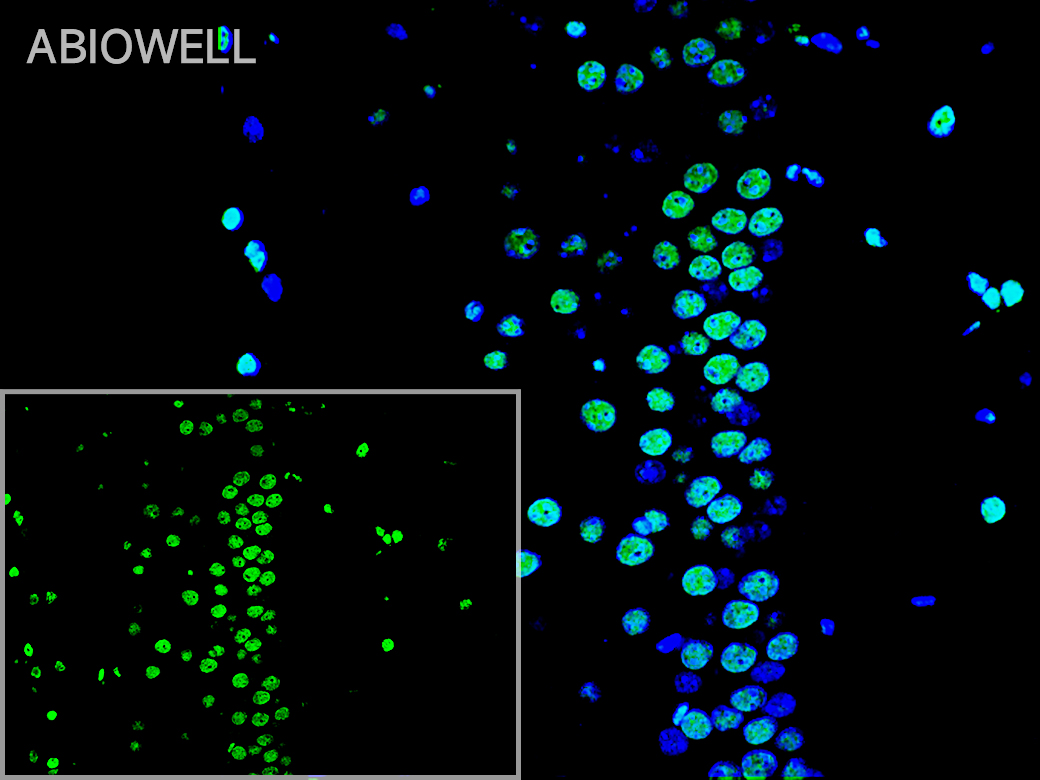
|
Fig: Fluorescence immunohistochemical analysis of Mouse-brain tissue (Formalin/PFA-fixed paraffin-embedded sections) with Rabbit anti-HMGB1 antibody (AWA10032) at 1/200 dilution. The immunostaining was performed with the TSA Immuno-staining Kit (ABIOWELL, AWI0688). The section was pre-treated using heat mediated antigen retrieval with Sodium citrate buffer (pH 6.0) for 20 minutes. The tissues were blocked in 3% H2O2 for 15 minutes at room temperature, washed with ddH2O and PBS, and then probed with the primary antibody (AWA10032) at 1/200 dilution for 2 hour at 37℃or overnignt at 4℃. The detection was performed using an HRP conjugated compact polymer system followed by a separate fluorescent tyramide signal amplification system (green). DAPI (blue, AWC0291) was used as a nuclear counter stain. Image acquisition was performed with Slide Scanner. |
-
-
- 20μL
- ¥620
- 1-3个工作日
-
- 50μL
- ¥1250
- 1-3个工作日
-
- 100μL
- ¥2200
- 1-3个工作日
-
相关产品
-
Cdk6 Recombinant Rabbit Monoclonal Antibody
GAPDH Rabbit Polyclonal Antibody
GFAP Recombinant Mouse Monoclonal Antibody
Ki67 Rabbit Monoclonal Antibody
HMGB1 Recombinant Rabbit Monoclonal Antibody
SQSTM1/p62 Mouse Monoclonal Antibody
Bcl-2 Recombinant Rabbit Monoclonal Antibody
SOD2 Rabbit Polyclonal Antibody

